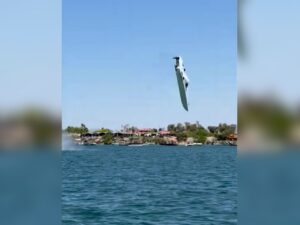On June 7 of last year, Henri van Breda was handed three life sentences by Western Cape High Court Judge Siraj Desai.
That makes him a convicted triple killer, which is something that became pretty obvious to the general public as the evidence emerged, although his defence team isn’t letting up in their attempts to overturn that verdict.
Last week, the Supreme Court of Appeal dismissed their application for leave to appeal both his conviction and sentencing, which means the Constitutional Court is his final shot at freedom.
His defence will use five main arguments, which have been summed up by TimesLIVE.
Let’s start with the security at the luxury De Zalze estate:
[It] came under the spotlight, with the state emphasising the hi-tech system used to keep intruders out. Security personnel testified on every aspect from the electric fence, to the cameras, to the booms, and to the various checks that are done around the clock. The state built a case of a Fort Knox-style security system.
The defence, for its part, pointed out the possibility of human error and possible loopholes, to build a case that it was possible someone had perforated the boundary and made his way to the house of the bloody murders. The state said there was no indication of anyone, or even any animal, gaining access to the estate.

However, the defence still insists there were “numerous ways in which perpetrators can breach a security fence that would not have required skill, experience or prior knowledge of the fence” or that water and wild animals created crawl spaces underneath the fence “from time to time”.
The defence always maintained that the murders were committed by an intruder (or intruders):
…Van Breda claimed that his family had been attacked by an axe-wielding stranger in a balaclava, and that this intruder had spoken to someone else in the house during the attack. The state argued, however, that there was no sign of an outsider being on the property and that Van Breda had created the narrative of an intruder, trying to use the high crime rates in SA by unknown assailants to his advantage.
His defence team is still insisting to the Constitutional Court that it is possible there was an intruder or intruders since “there are no cameras installed in the interior of the estate”, and that access to the Van Breda home would have been “easy” due to downstairs windows and the back door being open.
You know who else could easily enter the house? Henri.
Last year, footage emerged from inside the house, for those unfamiliar with the layout.
Next, we deal with the so-called “ear witness”:
There were no eyewitnesses to the De Zalze murders, other than Henri van Breda himself, and so it fell to an estate neighbour, Stephanie Op’t Hof, to provide what was ostensibly an “ear”-witness account: her husband was away at the time of the murders, and she recalled having heard a massive fight a few hours before the axe murders. She said she had heard aggressive male voices engaged in a fight earlier in the evening and had been taken aback. The defence then argued that it was actually the soundtrack of Star Trek 2 that she had been hearing, and not a fight among men at 12 Goske Street.
I’m not a ‘Trekkie’, as fans of Star Trek are known, but that seems a stretch from where I’m sitting.
The defence is also attempting to undermine Op’t Hof’s testimony by asking why she never reported the noise to security.
The fourth angle is trying to discredit the DNA evidence:
The state argued that DNA from Teresa (Van Breda’s mother) and Rudi (Van Breda’s brother) were found on nail scrapings taken from the accused, and that their DNA was also found in the bloodstains on his shorts. It also argued that in all 216 samples that were tested, enough good-quality DNA was present to make for an accurate finding.

The defence argued, however, that personnel at the lab had erred in allowing samples from the Van Breda family to follow one another on the work list when they should rather be separate to prevent cross-contamination, and that the results were not valid since the DNA was not of a high enough quality for testing.
Due to this, the defence claims that “the court erred in this regard, [placing] an onus on the applicant of disproving, as opposed to the state proving beyond reasonable doubt” that the evidence was reliable.
Finally, the fifth angle is Henri’s so-called epileptic seizures:
Fortuitous. That is what prosecutor Susan Galloway called the diagnosis of Henri van Breda’s condition of juvenile myoclonic epilepsy at a very late stage in the trial.
Two hours and 40 minutes were missing from the timeline of Van Breda’s narrative, but neurologist James Butler, the final defence witness, used the diagnosis to claim that Van Breda had a seizure on the night of the attacks and then suffered amnesia for nearly three hours as he lay on the staircase at 12 Goske Street, De Zalze.
The defence now insists that the high court disregarded Butler’s evidence. “There is unambiguous, independent and highly specific evidence that he has a generalised, as opposed to a focal form of epilepsy,” the defence says.
“There is compelling evidence that [Van Breda] experienced a general tonic-clonic seizure (a grand-mal seizure) on the evening of the murders.”
Very, very “fortuitous”.
According to Eric Ntabazalila, the National Prosecuting Authority spokesperson for the Western Cape region, the State now has until June 14 to file opposing papers in the Constitutional Court.
Henri van Breda’s last roll of the dice, and it really does look like a desperate one.
[source:timeslive]





